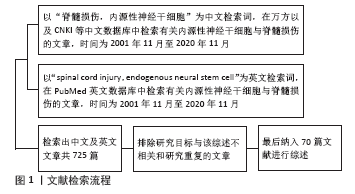[1] AHUJA CS, WILSON JR, NORI S, et al. Traumatic spinal cord injury. Nat Rev Dis Primers. 2017;3:17018.
[2] ROBERTS TT, LEONARD GR, CEPELA DJ. Classifications In Brief: American Spinal Injury Association (ASIA) Impairment Scale. Clin Orthop Relat Res. 2017;475(5):1499-1504.
[3] LI HL, XU H, LI YL, et al. Epidemiology of traumatic spinal cord injury in Tianjin, China: An 18-year retrospective study of 735 cases. J Spinal Cord Med. 2019;42(6):778-785.
[4] HAYTA E, ELDEN H. Acute spinal cord injury: A review of pathophysiology and potential of non-steroidal anti-inflammatory drugs for pharmacological intervention. J Chem Neuroanat. 2018;87:25-31.
[5] PAPA S, CARON I, ERBA E, et al. Early modulation of pro-inflammatory microglia by minocycline loaded nanoparticles confers long lasting protection after spinal cord injury. Biomaterials. 2016;75:13-24.
[6] KARNEZIS T, MANDEMAKERS W, MCQUALTER JL, et al. The neurite outgrowth inhibitor Nogo A is involved in autoimmune-mediated demyelination. Nat Neurosci. 2004;7(7):736-744.
[7] MAEDA Y, NAKAGOMI N, NAKANO-DOI A, et al. Potential of Adult Endogenous Neural Stem/Progenitor Cells in the Spinal Cord to Contribute to Remyelination in Experimental Autoimmune Encephalomyelitis. Cells. 2019;8(9):1025.
[8] HORNER PJ, POWER AE, KEMPERMANN G, et al. Proliferation and differentiation of progenitor cells throughout the intact adult rat spinal cord. J Neurosci. 2000;20(6):2218-2228.
[9] JURKOWSKI MP, BETTIO L, WOO EK, et al. Beyond the Hippocampus and the SVZ: Adult Neurogenesis Throughout the Brain. Front Cell Neurosci. 2020;14:576444.
[10] SILVA NA, SOUSA N, REIS RL, et al. From basics to clinical: a comprehensive review on spinal cord injury. Prog Neurobiol. 2014;114: 25-57.
[11] VISMARA I, PAPA S, ROSSI F, et al. Current Options for Cell Therapy in Spinal Cord Injury. Trends Mol Med. 2017;23(9):831-849.
[12] VAN NIEKERK EA, TUSZYNSKI MH, LU P, et al. Molecular and Cellular Mechanisms of Axonal Regeneration After Spinal Cord Injury. Mol Cell Proteomics. 2016;15(2):394-408.
[13] MELETIS K, BARNABÉ-HEIDER F, CARLÉN M, et al. Spinal cord injury reveals multilineage differentiation of ependymal cells. PLoS Biol. 2008;6(7):e182.
[14] BARNABÉ-HEIDER F, GÖRITZ C, SABELSTRÖM H, et al. Origin of new glial cells in intact and injured adult spinal cord. Cell Stem Cell. 2010; 7(4):470-482.
[15] KANG SH, FUKAYA M, YANG JK, et al. NG2+ CNS glial progenitors remain committed to the oligodendrocyte lineage in postnatal life and following neurodegeneration. Neuron. 2010;68(4):668-681.
[16] SOFRONIEW MV. Astrocyte Reactivity: Subtypes, States, and Functions in CNS Innate Immunity. Trends Immunol. 2020;41(9):758-770.
[17] COSKUN V, WU H, BLANCHI B, et al. CD133+ neural stem cells in the ependyma of mammalian postnatal forebrain. Proc Natl Acad Sci U S A. 2008;105(3):1026-1031.
[18] ALFARO-CERVELLO C, SORIANO-NAVARRO M, MIRZADEH Z, et al. Biciliated ependymal cell proliferation contributes to spinal cord growth. J Comp Neurol. 2012;520(15):3528-3552.
[19] PFENNINGER CV, STEINHOFF C, HERTWIG F, et al. Prospectively isolated CD133/CD24-positive ependymal cells from the adult spinal cord and lateral ventricle wall differ in their long-term in vitro self-renewal and in vivo gene expression. Glia. 2011;59(1):68-81.
[20] WEISS S, DUNNE C, HEWSON J, et al. Multipotent CNS stem cells are present in the adult mammalian spinal cord and ventricular neuroaxis. J Neurosci. 1996;16(23):7599-7609.
[21] SPASSKY N, MEUNIER A. The development and functions of multiciliated epithelia. Nat Rev Mol Cell Biol. 2017;18(7):423-436.
[22] GHAZALE H, RIPOLL C, LEVENTOUX N, et al. RNA Profiling of the Human and Mouse Spinal Cord Stem Cell Niches Reveals an Embryonic-like Regionalization with MSX1+ Roof-Plate-Derived Cells. Stem Cell Reports. 2019;12(5):1159-1177.
[23] KANEKO N, SAWAMOTO K. Go with the Flow: Cerebrospinal Fluid Flow Regulates Neural Stem Cell Proliferation. Cell Stem Cell. 2018;22(6): 783-784.
[24] HAMILTON LK, TRUONG MK, BEDNARCZYK MR, et al. Cellular organization of the central canal ependymal zone, a niche of latent neural stem cells in the adult mammalian spinal cord. Neuroscience. 2009;164(3):1044-1056.
[25] FABBIANI G, REALI C, VALENTÍN-KAHAN A, et al. Connexin Signaling Is Involved in the Reactivation of a Latent Stem Cell Niche after Spinal Cord Injury. J Neurosci. 2020;40(11):2246-2258.
[26] SONE K, MAENO K, MASAKI A, et al. Nestin Expression Affects Resistance to Chemotherapy and Clinical Outcome in Small Cell Lung Cancer. Front Oncol. 2020;10:1367.
[27] XU R, WU C, TAO Y, et al. Nestin-positive cells in the spinal cord: a potential source of neural stem cells. Int J Dev Neurosci. 2008;26(7): 813-820.
[28] XU Y, KITADA M, YAMAGUCHI M, et al. Increase in bFGF-responsive neural progenitor population following contusion injury of the adult rodent spinal cord. Neurosci Lett. 2006;397(3):174-179.
[29] NGUYEN T, MAO Y, SUTHERLAND T, et al. Neural progenitor cells but not astrocytes respond distally to thoracic spinal cord injury in rat models. Neural Regen Res. 2017;12(11):1885-1894.
[30] MCTIGUE DM, WEI P, STOKES BT. Proliferation of NG2-positive cells and altered oligodendrocyte numbers in the contused rat spinal cord. J Neurosci. 2001;21(10):3392-3400.
[31] LIU SM, XIAO ZF, LI X, et al. Vascular endothelial growth factor activates neural stem cells through epidermal growth factor receptor signal after spinal cord injury. CNS Neurosci Ther. 2019;25(3):375-385.
[32] KOJIMA A, TATOR CH. Epidermal growth factor and fibroblast growth factor 2 cause proliferation of ependymal precursor cells in the adult rat spinal cord in vivo. J Neuropathol Exp Neurol. 2000;59(8): 687-697.
[33] ROMANO R, BUCCI C. Role of EGFR in the Nervous System. Cells. 2020; 9(8):1887.
[34] ZHOU QZ, ZHANG G, LONG HB, et al. Effect of spinal cord extracts after spinal cord injury on proliferation of rat embryonic neural stem cells and Notch signal pathway in vitro. Asian Pac J Trop Med. 2014;7(7): 562-567.
[35] KWIECIEN JM, DABROWSKI W, DĄBROWSKA-BOUTA B, et al. Prolonged inflammation leads to ongoing damage after spinal cord injury. PLoS One. 2020;15(3):e0226584.
[36] MLADINIC M, BIANCHETTI E, DEKANIC A, et al. ATF3 is a novel nuclear marker for migrating ependymal stem cells in the rat spinal cord. Stem Cell Res. 2014;12(3):815-827.
[37] MORENO-MANZANO V, RODRÍGUEZ-JIMÉNEZ FJ, GARCÍA-ROSELLÓ M, et al. Activated spinal cord ependymal stem cells rescue neurological function. Stem Cells. 2009;27(3):733-743.
[38] GRÉGOIRE CA, GOLDENSTEIN BL, FLORIDDIA EM, et al. Endogenous neural stem cell responses to stroke and spinal cord injury. Glia. 2015; 63(8):1469-1482.
[39] ANJUM A, YAZID MD, FAUZI DAUD M, et al. Spinal Cord Injury: Pathophysiology, Multimolecular Interactions, and Underlying Recovery Mechanisms. Int J Mol Sci. 2020;21(20):7533.
[40] SABELSTRÖM H, STENUDD M, RÉU P, et al. Resident neural stem cells restrict tissue damage and neuronal loss after spinal cord injury in mice. Science. 2013;342(6158):637-640.
[41] LINNERBAUER M, ROTHHAMMER V. Protective Functions of Reactive Astrocytes Following Central Nervous System Insult. Front Immunol. 2020;11:573256.
[42] BELLER JA, SNOW DM. Proteoglycans: road signs for neurite outgrowth. Neural Regen Res. 2014;9(4):343-355.
[43] YUAN YM, HE C. The glial scar in spinal cord injury and repair. Neurosci Bull. 2013;29(4):421-435.
[44] CAO QL, ZHANG YP, HOWARD RM, et al. Pluripotent stem cells engrafted into the normal or lesioned adult rat spinal cord are restricted to a glial lineage. Exp Neurol. 2001;167(1):48-58.
[45] YANG H, LU P, MCKAY HM, et al. Endogenous neurogenesis replaces oligodendrocytes and astrocytes after primate spinal cord injury. J Neurosci. 2006;26(8):2157-2166.
[46] FILBIN MT. Myelin-associated inhibitors of axonal regeneration in the adult mammalian CNS. Nat Rev Neurosci. 2003;4(9):703-713.
[47] BRADBURY EJ, OLIVEIRA R. Inhibiting an inhibitor: a decoy to recover dexterity after spinal cord injury. Brain. 2020;143(6):1618-1622.
[48] WANG B, XIAO Z, CHEN B, et al. Nogo-66 promotes the differentiation of neural progenitors into astroglial lineage cells through mTOR-STAT3 pathway. PLoS One. 2008;3(3):e1856.
[49] ZHAO Y, XIAO Z, CHEN B, et al. The neuronal differentiation microenvironment is essential for spinal cord injury repair. Organogenesis. 2017;13(3):63-70.
[50] GUAN B, CHEN R, ZHONG M, et al. Protective effect of Oxymatrine against acute spinal cord injury in rats via modulating oxidative stress, inflammation and apoptosis. Metab Brain Dis. 2020;35(1):149-157.
[51] FAN C, LI X, XIAO Z, et al. A modified collagen scaffold facilitates endogenous neurogenesis for acute spinal cord injury repair. Acta Biomater. 2017;51:304-316.
[52] HACHEM LD, MOTHE AJ, TATOR CH. Glutamate Increases In Vitro Survival and Proliferation and Attenuates Oxidative Stress-Induced Cell Death in Adult Spinal Cord-Derived Neural Stem/Progenitor Cells via Non-NMDA Ionotropic Glutamate Receptors. Stem Cells Dev. 2016;25(16):1223-1233.
[53] BRAZEL CY, NUÑEZ JL, YANG Z, et al. Glutamate enhances survival and proliferation of neural progenitors derived from the subventricular zone. Neuroscience. 2005;131(1):55-65.
[54] HACHEM LD, MOTHE AJ, TATOR CH. Positive Modulation of AMPA Receptors Promotes Survival and Proliferation of Neural Stem/Progenitor Cells from the Adult Rat Spinal Cord. Stem Cells Dev. 2017;26(23):1675-1681.
[55] MAZZONE GL, MLADINIC M, NISTRI A. Excitotoxic cell death induces delayed proliferation of endogenous neuroprogenitor cells in organotypic slice cultures of the rat spinal cord. Cell Death Dis. 2013; 4(10):e902.
[56] HACHEM LD, MOTHE AJ, TATOR CH. Effect of BDNF and Other Potential Survival Factors in Models of In Vitro Oxidative Stress on Adult Spinal Cord-Derived Neural Stem/Progenitor Cells. Biores Open Access. 2015;4(1):146-159.
[57] MA Y, DENG M, LIU M. Effect of Differently Polarized Macrophages on Proliferation and Differentiation of Ependymal Cells from Adult Spinal Cord. J Neurotrauma. 2019;36(15):2337-2347.
[58] GÓMEZ-VILLAFUERTES R, RODRÍGUEZ-JIMÉNEZ FJ, ALASTRUE-AGUDO A, et al. Purinergic Receptors in Spinal Cord-Derived Ependymal Stem/Progenitor Cells and Their Potential Role in Cell-Based Therapy for Spinal Cord Injury. Cell Transplant. 2015;24(8):1493-1509.
[59] UDA Y, XU S, MATSUMURA T, et al. P2Y4 Nucleotide Receptor in Neuronal Precursors Induces Glutamatergic Subtype Markers in Their Descendant Neurons. Stem Cell Reports. 2016;6(4):474-482.
[60] LE BELLE JE, OROZCO NM, PAUCAR AA, et al. Proliferative neural stem cells have high endogenous ROS levels that regulate self-renewal and neurogenesis in a PI3K/Akt-dependant manner. Cell Stem Cell. 2011;8(1):59-71.
[61] HU Q, KHANNA P, EE WONG BS, et al. Oxidative stress promotes exit from the stem cell state and spontaneous neuronal differentiation. Oncotarget. 2017;9(3):4223-4238.
[62] 代杰,盛伟斌,谢江,等.无骨折脱位型颈椎脊髓损伤的治疗策略[J].中国骨与关节损伤杂志,2020,35(7):673-675.
[63] AHUJA CS, NORI S, TETREAULT L, et al. Traumatic Spinal Cord Injury-Repair and Regeneration. Neurosurgery. 2017;80(3S):S9-S22.
[64] LI X, FAN C, XIAO Z, et al. A collagen microchannel scaffold carrying paclitaxel-liposomes induces neuronal differentiation of neural stem cells through Wnt/β-catenin signaling for spinal cord injury repair. Biomaterials. 2018;183:114-127.
[65] WILSON NH, STOECKLI ET. Sonic Hedgehog regulates Wnt activity during neural circuit formation. Vitam Horm. 2012;88:173-209.
[66] YANG Z, ZHANG A, DUAN H, et al. NT3-chitosan elicits robust endogenous neurogenesis to enable functional recovery after spinal cord injury. Proc Natl Acad Sci U S A. 2015;112(43):13354-13359.
[67] LIAU LL, RUSZYMAH BHI, NG MH, et al. Characteristics and clinical applications of Wharton’s jelly-derived mesenchymal stromal cells. Curr Res Transl Med. 2020;68(1):5-16.
[68] HUANG JH, YIN XM, XU Y, et al. Systemic Administration of Exosomes Released from Mesenchymal Stromal Cells Attenuates Apoptosis, Inflammation, and Promotes Angiogenesis after Spinal Cord Injury in Rats. J Neurotrauma. 2017;34(24):3388-3396.
[69] MCBRIDE JD, RODRIGUEZ-MENOCAL L, GUZMAN W, et al. Bone Marrow Mesenchymal Stem Cell-Derived CD63+ Exosomes Transport Wnt3a Exteriorly and Enhance Dermal Fibroblast Proliferation, Migration, and Angiogenesis In Vitro. Stem Cells Dev. 2017;26(19):1384-1398.
[70] PAL R, VENKATARAMANA NK, BANSAL A, et al. Ex vivo-expanded autologous bone marrow-derived mesenchymal stromal cells in human spinal cord injury/paraplegia: a pilot clinical study. Cytotherapy. 2009;11(7):897-911.
|


